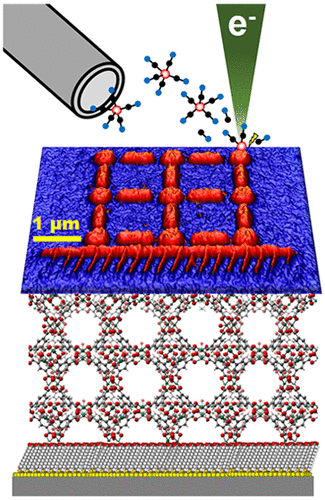Our official English website, www.x-mol.net, welcomes your
feedback! (Note: you will need to create a separate account there.)
Surface-Anchored Metal–Organic Frameworks as Versatile Resists for Gas-Assisted E-Beam Lithography: Fabrication of Sub-10 Nanometer Structures
ACS Nano ( IF 15.8 ) Pub Date : 2018-03-14 00:00:00 , DOI: 10.1021/acsnano.8b01071 Martin Drost 1 , Fan Tu 1 , Luisa Berger 1 , Christian Preischl 1 , Wencai Zhou 2 , Hartmut Gliemann 2 , Christof Wöll 2 , Hubertus Marbach 1
ACS Nano ( IF 15.8 ) Pub Date : 2018-03-14 00:00:00 , DOI: 10.1021/acsnano.8b01071 Martin Drost 1 , Fan Tu 1 , Luisa Berger 1 , Christian Preischl 1 , Wencai Zhou 2 , Hartmut Gliemann 2 , Christof Wöll 2 , Hubertus Marbach 1
Affiliation

|
We demonstrate that surface-anchored metal–organic frameworks (SURMOFs) are extraordinary well-suited as resists for high-resolution focused electron beam induced processing (FEBIP) techniques. The combination of such powerful lithographic protocols with the huge versatility of MOF materials are investigated in respect to their potential in nanostructures fabrication. The applied FEBIP methods rely on the local decomposition of Fe(CO)5 and Co(CO)3NO as precursors, either by the direct impact of the focused electron beam (electron beam induced deposition, EBID) or through the interaction of the precursor molecules with preirradiated/activated SURMOF areas (electron beam induced surface activation, EBISA). We demonstrate the huge potential of the approach for two different types of MOFs (HKUST-1 and Zn-DPDCPP). Our “surface science” approach to FEBIP, yields well-defined deposits with each investigated precursor/SURMOF combination. Local Auger electron spectroscopy reveals clean iron deposits from Fe(CO)5; deposits from Co(CO)3NO contain cobalt, nitrogen, and oxygen. EBISA experiments were successful with Fe(CO)5. Remarkably EBISA with Co(CO)3NO does not result in deposit formation on both resists, making the process chemically selective. Most importantly we demonstrate the fabrication of “nested-L” test structures with Fe(CO)5 on HKUST-1 with extremely narrow line widths of partially less than 8 nm, due to reduced electron proximity effects within the MOF-based resists. Considering that the actual diameter of the electron beam was larger than 6 nm, we see a huge potential for significant reduction of the structure sizes. In addition, the role and high potential of loading and transport of the precursor molecules within the porous SURMOF materials is discussed.
中文翻译:

表面锚固的金属有机框架可作为多功能气体辅助电子束光刻技术:10纳米以下结构的制造
我们证明,表面锚定的金属有机框架(SURMOFs)非常适合用作高分辨率聚焦电子束诱导处理(FEBIP)技术的抗蚀剂。就其在纳米结构制造中的潜力而言,研究了这种强大的光刻协议与MOF材料的巨大多功能性的结合。所应用的FEBIP方法依赖于Fe(CO)5和Co(CO)3的局部分解通过聚焦电子束的直接冲击(电子束诱导沉积,EBID)或通过前体分子与预辐照/活化的SURMOF区域的相互作用(电子束诱导的表面活化,EBISA)将NO用作前体。我们证明了该方法对于两种不同类型的MOF(HKUST-1和Zn-DPDCPP)的巨大潜力。我们对FEBIP的“表面科学”方法,通过研究的每种前驱体/ SURMOF组合均可产生定义明确的沉积物。局部俄歇电子能谱显示Fe(CO)5中有干净的铁沉积物。Co(CO)3 NO的沉积物包含钴,氮和氧。用Fe(CO)5成功进行了EBISA实验。具有Co(CO)3的EBISA显着NO不会在两种抗蚀剂上形成沉积物,从而使该过程具有化学选择性。最重要的是,我们证明了在HKUST-1上使用Fe(CO)5制备“嵌套L”测试结构的方法,由于基于MOF的抗蚀剂在电子上的邻近效应减小,因此线宽极窄,部分小于8 nm。考虑到电子束的实际直径大于6 nm,我们看到了巨大的潜力,可以显着减小结构尺寸。另外,讨论了多孔SURMOF材料中前体分子的装载和运输的作用和高潜力。
更新日期:2018-03-14
中文翻译:

表面锚固的金属有机框架可作为多功能气体辅助电子束光刻技术:10纳米以下结构的制造
我们证明,表面锚定的金属有机框架(SURMOFs)非常适合用作高分辨率聚焦电子束诱导处理(FEBIP)技术的抗蚀剂。就其在纳米结构制造中的潜力而言,研究了这种强大的光刻协议与MOF材料的巨大多功能性的结合。所应用的FEBIP方法依赖于Fe(CO)5和Co(CO)3的局部分解通过聚焦电子束的直接冲击(电子束诱导沉积,EBID)或通过前体分子与预辐照/活化的SURMOF区域的相互作用(电子束诱导的表面活化,EBISA)将NO用作前体。我们证明了该方法对于两种不同类型的MOF(HKUST-1和Zn-DPDCPP)的巨大潜力。我们对FEBIP的“表面科学”方法,通过研究的每种前驱体/ SURMOF组合均可产生定义明确的沉积物。局部俄歇电子能谱显示Fe(CO)5中有干净的铁沉积物。Co(CO)3 NO的沉积物包含钴,氮和氧。用Fe(CO)5成功进行了EBISA实验。具有Co(CO)3的EBISA显着NO不会在两种抗蚀剂上形成沉积物,从而使该过程具有化学选择性。最重要的是,我们证明了在HKUST-1上使用Fe(CO)5制备“嵌套L”测试结构的方法,由于基于MOF的抗蚀剂在电子上的邻近效应减小,因此线宽极窄,部分小于8 nm。考虑到电子束的实际直径大于6 nm,我们看到了巨大的潜力,可以显着减小结构尺寸。另外,讨论了多孔SURMOF材料中前体分子的装载和运输的作用和高潜力。











































 京公网安备 11010802027423号
京公网安备 11010802027423号